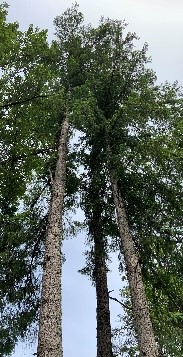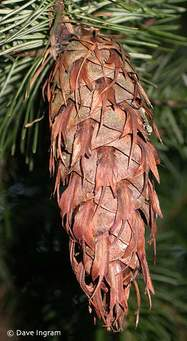Douglas Fir (Psuedotsuga menziesii)
Our native Douglas Fir, which is so prevalent throughout the Lake Wilderness Arboretum, was mostly used as fuel for cooking by native peoples. The wood was also used for tools such as spear and harpoon shafts, fishing hooks and for handles. The branches were used for covering the floors of lodges and sweat lodges as well as for purifying and warding off ghosts in some Salish and other Northwest Indian rituals. Fir bark and resin have also been used as medicine herbs by many Native Americans.
The Douglas fir has long been associated with protection by the native cultures of the Pacific Northwest. Native folklore weaves a story of a great forest fire and a mouse seeking refuge in the canopy of the tree. The Douglas fir thought its thick bark would protect it from the ravages of the fire below and invited the mouse and those that would follow, to climb into his massive canopy and find shelter in his cones. The mice did so, leaving their feet and tails exposed beneath the thumb shaped scales of the cone – and both the tree and the mice survive the great fire. Other versions of this fable portray mice seeking shelter from a dire storm or deep snow and famine. To this day, when you look closely at a Douglas Fir cone, the mouse’s back legs and tail are still visible beneath the cone’s scales!

A native Douglas Fir 
A Douglas Fir cone
